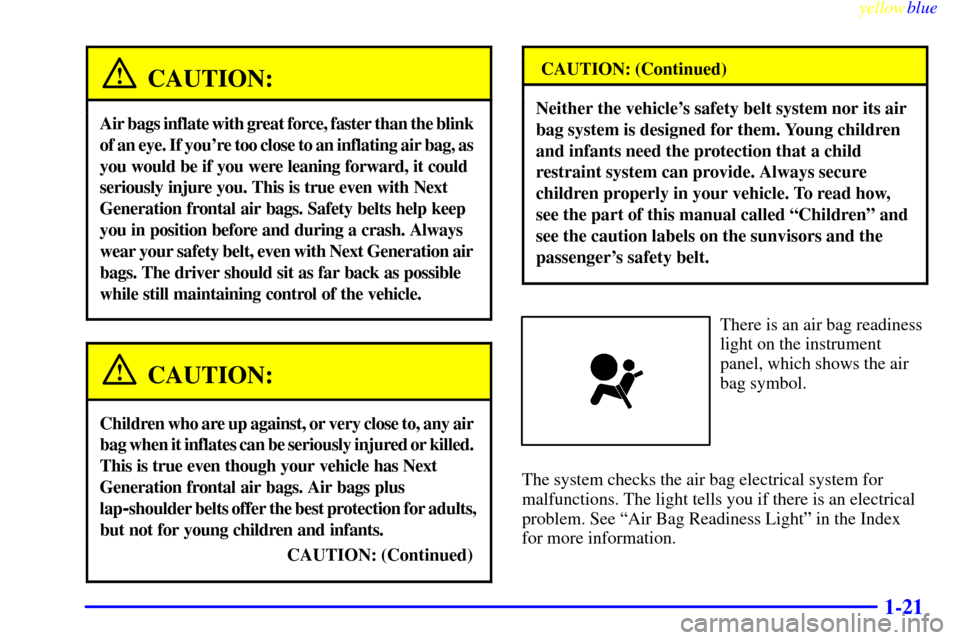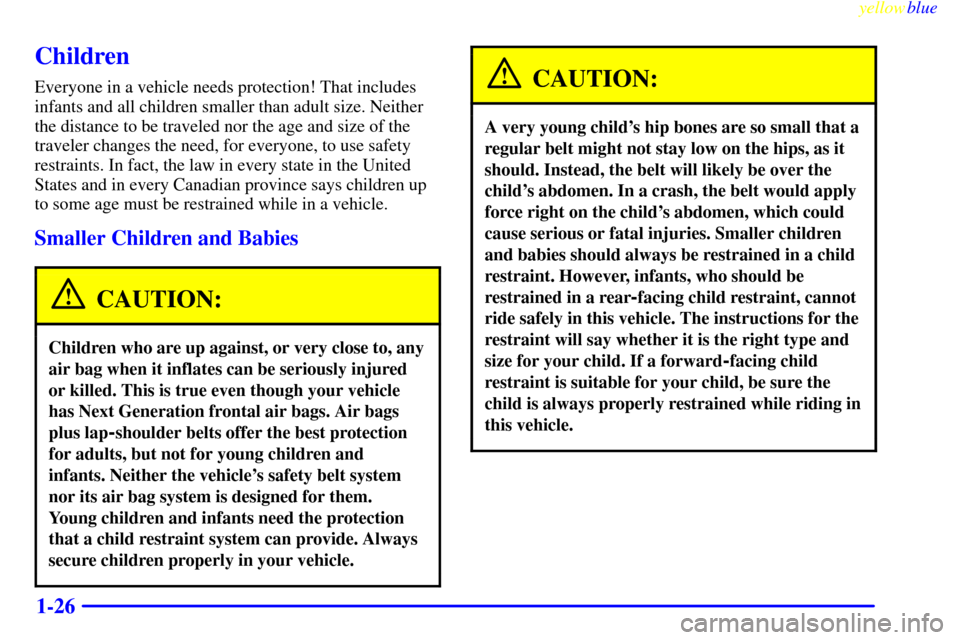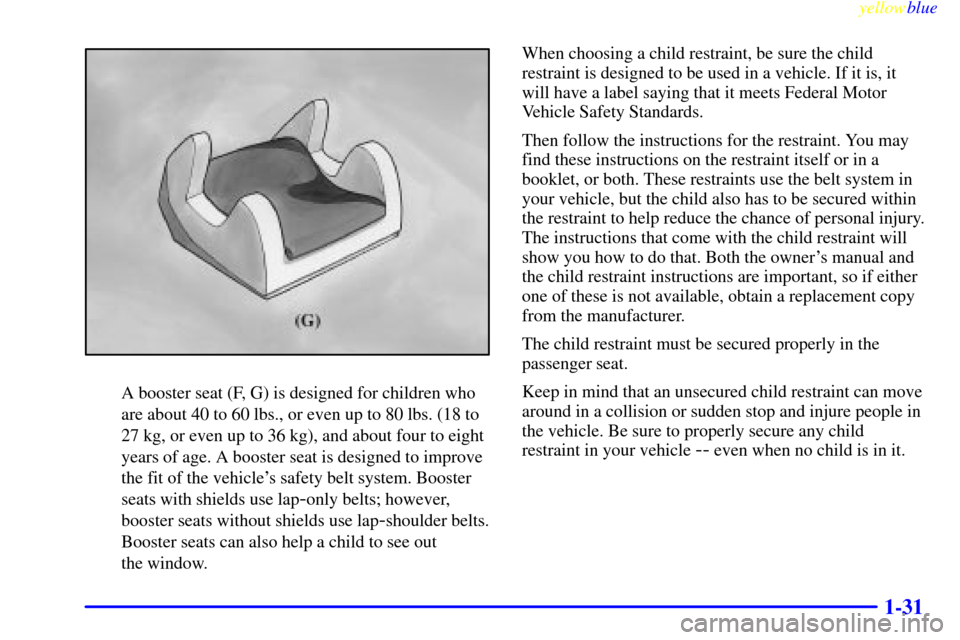Page 33 of 376

yellowblue
1-21
CAUTION:
Air bags inflate with great force, faster than the blink
of an eye. If you're too close to an inflating air bag, as
you would be if you were leaning forward, it could
seriously injure you. This is true even with Next
Generation frontal air bags. Safety belts help keep
you in position before and during a crash. Always
wear your safety belt, even with Next Generation air
bags. The driver should sit as far back as possible
while still maintaining control of the vehicle.
CAUTION:
Children who are up against, or very close to, any air
bag when it inflates can be seriously injured or killed.
This is true even though your vehicle has Next
Generation frontal air bags. Air bags plus
lap
-shoulder belts offer the best protection for adults,
but not for young children and infants.
CAUTION: (Continued)
CAUTION: (Continued)
Neither the vehicle's safety belt system nor its air
bag system is designed for them. Young children
and infants need the protection that a child
restraint system can provide. Always secure
children properly in your vehicle. To read how,
see the part of this manual called ªChildrenº and
see the caution labels on the sunvisors and the
passenger's safety belt.
There is an air bag readiness
light on the instrument
panel, which shows the air
bag symbol.
The system checks the air bag electrical system for
malfunctions. The light tells you if there is an electrical
problem. See ªAir Bag Readiness Lightº in the Index
for more information.
Page 36 of 376

yellowblue
1-24
How does an air bag restrain?
In moderate to severe frontal or near
-frontal collisions,
even belted occupants can contact the steering wheel or
the instrument panel. Air bags supplement the protection
provided by safety belts. Air bags distribute the force of
the impact more evenly over the occupant's upper body,
stopping the occupant more gradually. But air bags
would not help you in many types of collisions,
including rollovers, rear impacts and side impacts,
primarily because an occupant's motion is not toward
those air bags. Air bags should never be regarded as
anything more than a supplement to safety belts,
and then only in moderate to severe frontal or
near
-frontal collisions.
What will you see after an air bag inflates?
After an air bag inflates, it quickly deflates, so quickly
that some people may not even realize the air bag
inflated. Some components of the air bag module
-- the
steering wheel hub for the driver's air bag, or the
instrument panel for the passenger's bag
-- will be hot
for a short time. The parts of the bag that come into
contact with you may be warm, but not too hot to touch.
There will be some smoke and dust coming from vents
in the deflated air bags. Air bag inflation doesn't prevent
the driver from seeing or from being able to steer the
vehicle, nor does it stop people from leaving the vehicle.
CAUTION:
When an air bag inflates, there is dust in the air.
This dust could cause breathing problems for
people with a history of asthma or other
breathing trouble. To avoid this, everyone in the
vehicle should get out as soon as it is safe to do so.
If you have breathing problems but can't get out
of the vehicle after an air bag inflates, then get
fresh air by opening a window or door.
In many crashes severe enough to inflate an air bag,
windshields are broken by vehicle deformation.
Additional windshield breakage may also occur from the
passenger air bag.
�Air bags are designed to inflate only once. After they
inflate, you'll need some new parts for your air bag
system. If you don't get them, the air bag system
won't be there to help protect you in another crash.
A new system will include air bag modules and
possibly other parts. The service manual for your
vehicle covers the need to replace other parts.
Page 37 of 376

yellowblue
1-25
�Your vehicle is equipped with a diagnostic module,
which records information about the air bag system.
The module records information about the readiness
of the system, when the sensors are activated and
driver's safety belt usage at deployment. Some
modules also record speed, engine rpm, brake and
throttle data.
�Let only qualified technicians work on your air bag
system. Improper service can mean that your air bag
system won't work properly. See your dealer
for service.
NOTICE:
If you damage the covering for the driver's or the
passenger's air bag, the bag may not work
properly. You may have to replace the air bag
module in the steering wheel or both the air bag
module and the instrument panel for the
passenger's air bag. Do not open or break the air
bag coverings.
Servicing Your Air Bag-Equipped Vehicle
Air bags affect how your vehicle should be serviced.
There are parts of the air bag system in several places
around your vehicle. You don't want the system to
inflate while someone is working on your vehicle. Your
dealer and the Corvette Service Manual have
information about servicing your vehicle and the air bag
system. To purchase a service manual, see ªService and
Owner Publicationsº in the Index.
CAUTION:
For up to 10 minutes after the ignition key is
turned off and the battery is disconnected, an air
bag can still inflate during improper service. You
can be injured if you are close to an air bag when
it inflates. Avoid yellow wires, wires wrapped
with yellow tape or yellow connectors. They are
probably part of the air bag system. Be sure to
follow proper service procedures, and make sure
the person performing work for you is qualified
to do so.
The air bag system does not need regular maintenance.
Page 38 of 376

yellowblue
1-26
Children
Everyone in a vehicle needs protection! That includes
infants and all children smaller than adult size. Neither
the distance to be traveled nor the age and size of the
traveler changes the need, for everyone, to use safety
restraints. In fact, the law in every state in the United
States and in every Canadian province says children up
to some age must be restrained while in a vehicle.
Smaller Children and Babies
CAUTION:
Children who are up against, or very close to, any
air bag when it inflates can be seriously injured
or killed. This is true even though your vehicle
has Next Generation frontal air bags. Air bags
plus lap
-shoulder belts offer the best protection
for adults, but not for young children and
infants. Neither the vehicle's safety belt system
nor its air bag system is designed for them.
Young children and infants need the protection
that a child restraint system can provide. Always
secure children properly in your vehicle.
CAUTION:
A very young child's hip bones are so small that a
regular belt might not stay low on the hips, as it
should. Instead, the belt will likely be over the
child's abdomen. In a crash, the belt would apply
force right on the child's abdomen, which could
cause serious or fatal injuries. Smaller children
and babies should always be restrained in a child
restraint. However, infants, who should be
restrained in a rear
-facing child restraint, cannot
ride safely in this vehicle. The instructions for the
restraint will say whether it is the right type and
size for your child. If a forward
-facing child
restraint is suitable for your child, be sure the
child is always properly restrained while riding in
this vehicle.
Page 43 of 376

yellowblue
1-31
A booster seat (F, G) is designed for children who
are about 40 to 60 lbs., or even up to 80 lbs. (18 to
27 kg, or even up to 36 kg), and about four to eight
years of age. A booster seat is designed to improve
the fit of the vehicle's safety belt system. Booster
seats with shields use lap
-only belts; however,
booster seats without shields use lap
-shoulder belts.
Booster seats can also help a child to see out
the window.When choosing a child restraint, be sure the child
restraint is designed to be used in a vehicle. If it is, it
will have a label saying that it meets Federal Motor
Vehicle Safety Standards.
Then follow the instructions for the restraint. You may
find these instructions on the restraint itself or in a
booklet, or both. These restraints use the belt system in
your vehicle, but the child also has to be secured within
the restraint to help reduce the chance of personal injury.
The instructions that come with the child restraint will
show you how to do that. Both the owner's manual and
the child restraint instructions are important, so if either
one of these is not available, obtain a replacement copy
from the manufacturer.
The child restraint must be secured properly in the
passenger seat.
Keep in mind that an unsecured child restraint can move
around in a collision or sudden stop and injure people in
the vehicle. Be sure to properly secure any child
restraint in your vehicle
-- even when no child is in it.
Page 46 of 376
yellowblue
1-34
You'll be using the lap-shoulder belt. See the earlier part
about the top strap if the child restraint has one. Be sure
to follow the instructions that came with the child
restraint. Secure the child in the child restraint when and
as the instructions say.
1. Because your vehicle has a passenger air bag, always
move the seat as far back as it will go before
securing a forward
-facing child restraint. (See
ªSeatsº in the Index.)
2. Put the restraint on the seat.
3. Pick up the latch plate, and run the lap and shoulder
portions of the vehicle's safety belt through or
around the restraint. The child restraint instructions
will show you how.
If the shoulder belt goes in front of the child's face or
neck, put it behind the child restraint.
4. Buckle the belt. Make sure the release button is
positioned so you would be able to unbuckle the
safety belt quickly if you ever had to.
Page 47 of 376
yellowblue
1-35
5. Pull the rest of the lap belt all the way out of the
retractor to set the lock.6. To tighten the belt, feed the lap belt back into the
retractor while you push down on the child restraint.
You may find it helpful to use your knee to push
down on the child restraint as you tighten the belt.
7. Push and pull the child restraint in different
directions to be sure it is secure.
To remove the child restraint, just unbuckle the vehicle's
safety belt and let it go back all the way. The safety belt
will move freely again and be ready to work for an adult
or larger child passenger.
Page 48 of 376
yellowblue
1-36
Larger ChildrenChildren who have outgrown child restraints should
wear the vehicle's safety belts.
�Children who aren't buckled up can be thrown out in
a crash.
�Children who aren't buckled up can strike other
people who are.